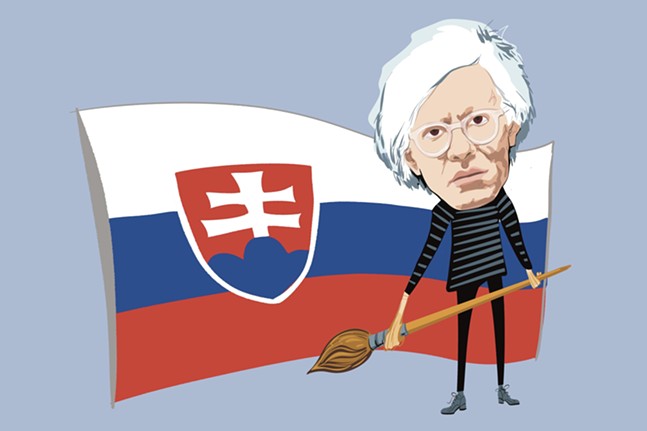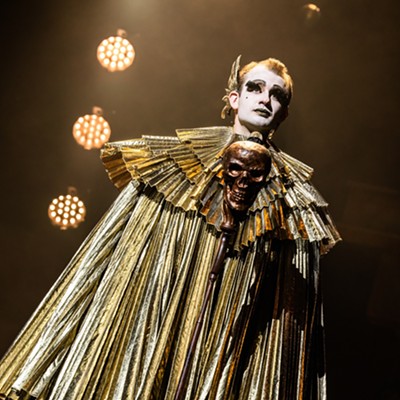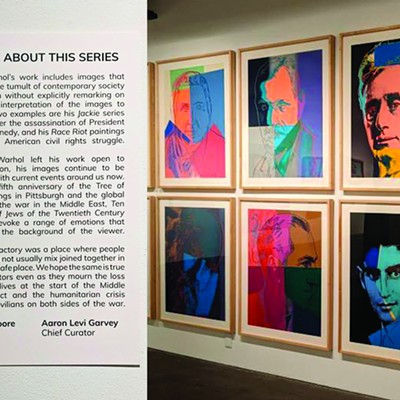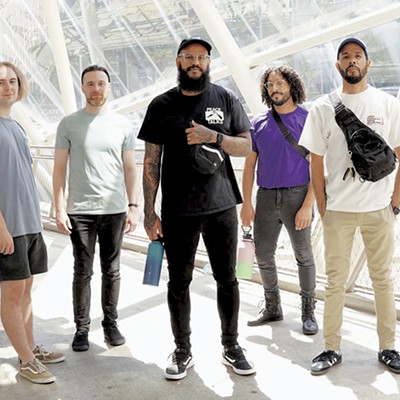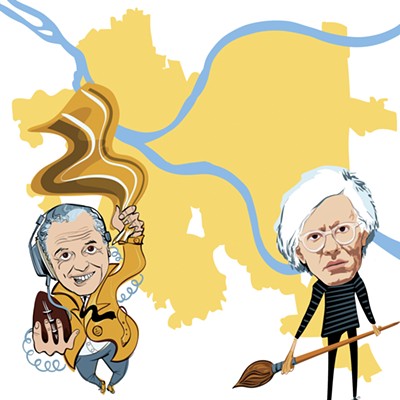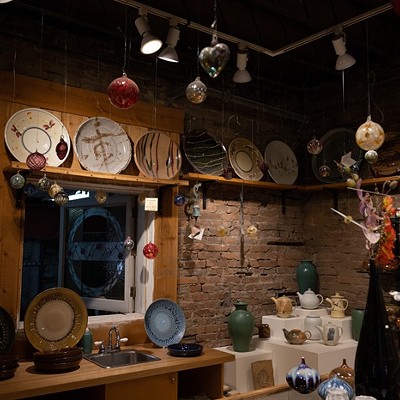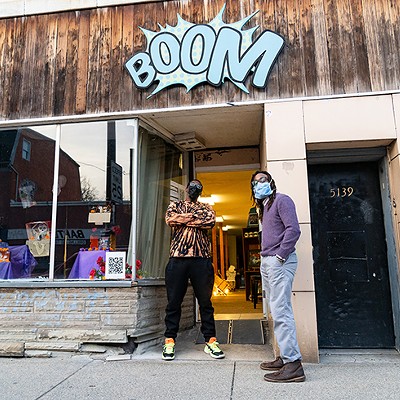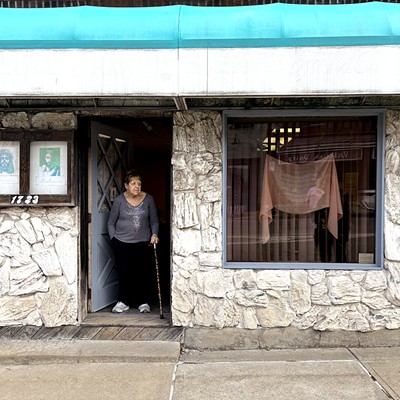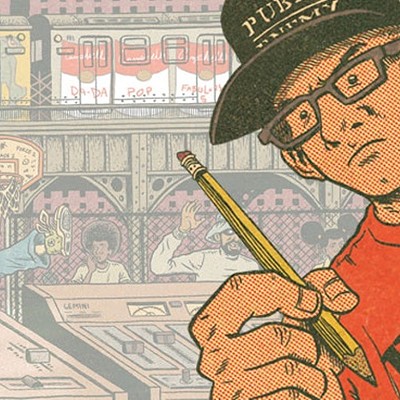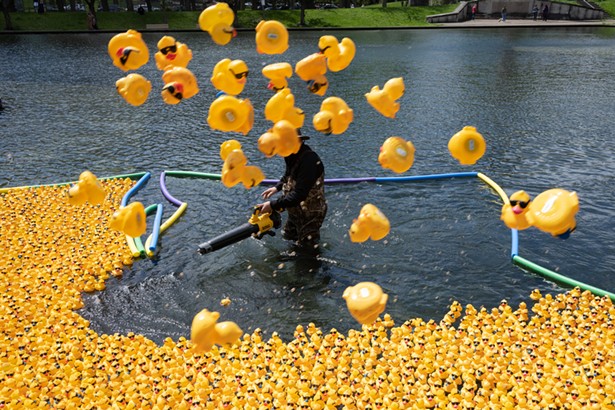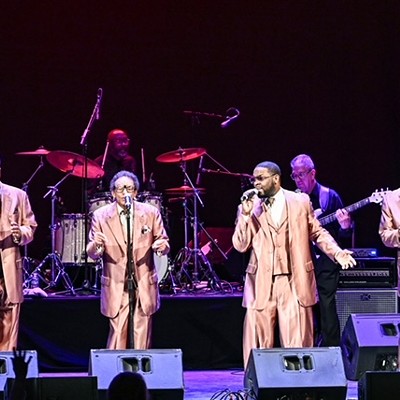On Feb. 22, the 37th anniversary of his death, the Pittsburgh native posthumously received the Order of the White Double Cross of the Second Class, the highest honor that Slovakia awards foreigners and civilians, for promoting the country’s good name abroad. In the Andy Warhol Museum on the North Side, Radovan Javorčík, Slovak ambassador to the United States, presented the beribboned gold medal surrounded by the artist’s works. Paintings of Warhol’s straight-laced, silver-haired mother contrasted with a nearly two-story photograph of him holding an acetate of platinum blonde Marilyn Monroe’s sensuous face.
“Andy Warhol and his work fulfill the definition of timelessness or even eternity,” Javorčík said, presenting the medal to Warhol's nephew and Andy Warhol Foundation liaison Donald Warhola. “There is also no doubt that Andy Warhol would not have become what he was if he had not grown up and created in the United States. But on the other hand, maybe it was his Slovak and Ruthenian origin that gave him the genes that influenced his work and his nature.”
Slovak President Zuzana Čaputová had planned to bestow the medal here on Feb. 4 before she became ill with COVID-19.
The ceremony in a sense plays out a political battle inside Slovakia. The pro-West woman president honored an American, convention-smashing artist who was openly gay. Meanwhile, recently elected Prime Minister Robert Fico touts Russia and conservative values, bashes immigrants and the United States, and pushes a new law that some Slovaks fear could promote corruption and other crimes.
Uncle Andy
Andy Warhol, the youngest of three sons, was born in Oakland to Andrej and Julia Warhola. His parents grew up in the village of Míkova in northeastern Slovakia, then part of the Austro-Hungarian Empire and now a landlocked nation of 5.5 million people in Central Europe. His father, a coal miner, moved here before World War One, followed by his wife.Icons decorated the Warhola house, and the family attended Mass at St. John Chrysostom Byzantine Catholic Church in Greenfield. Warhol may have picked up his artistic bent from his mother who sketched cats and angels in pencil. The family gift of a Baby Brownie Special camera when he was eight may have furthered his interest in art.
Afflicted with facial tics and pigmented skin, Warhol was, when not bedridden, the subject of taunts like “Spot.” Having developed an early interest in celebrity, he wrote child screen star Shirley Temple and received an autographed photo.
Donald Warhola recalled other early tales of Uncle Andy.
“I don’t think his father came home from work and gave him a big hug,” Warhola said. But his father paid $3,200 for a foreclosed house on Dawson Street across from Holmes School so that his boys could sleep in a half hour longer before school.
Andrej Warhola died when Andy was just 13. Nevertheless, his father had saved $1,500 to send him to Carnegie Institute of Technology, now Carnegie Mellon University. Warhol headed to New York City, dropped the “a” in his last name and launched a career in commercial art.
Donald Warhola used to stay at his uncle’s home during family visits to New York and briefly worked for him before his death. After a deranged hanger-on shot and nearly killed him in 1968, Warhol put up his family in a hotel during visits and for the rest of his life wore a corset to keep his insides from spilling out.
The nephew said he sees Warhol’s Slovak roots from the humor in his art. Citing Warhol’s film “Sleep,” Warhola said his uncle would have loved a camera recording the audience’s reaction to nearly five and a half hours of a man in slumber. “I think he made (the movies) for the reaction,” Warhola said.
Warhola said Uncle Andy not only branded his art, but also himself. Besides shortening his name, he sported sunglasses, underwent cosmetic surgery for his nose, and wore a wig to hide his thin hair and makeup for his blotches.
His influence on culture was manifold. He managed The Velvet Underground, a band later inducted into the Rock and Roll Hall of Fame. He founded Interview magazine, a forerunner of celebrity media. And he transformed art long focused on madonnas and the mighty by painting and elevating the mundane.
“He wanted to make a statement that this Listerine bottle, the S&H green stamp, or the Campbell’s soup can label was art and art that was worthy of being in a museum,” said Warhola,.
A changing Slovakia
The awarding of the medal came a day after the sixth anniversary of the murder of Ján Kuciak, an anti-corruption journalist, and his fiancée Martina Kušnírová. That crime sparked protests throughout Slovakia — and in Pittsburgh — and forced Fico to resign. Protests in Slovakia last week again marked the anniversary and opposed Fico’s proposed law to abolish the nation’s special prosecutor for corruption, reduce penalties for financial crimes, and lower the statute of limitations for rape and corruption.“It’s shocking, when we look back to Kuciak’s murder, that the same politician is back,” said Renáta Kamenárová, director of the Slovak Studies Program at the University of Pittsburgh.
The individuals directly involved in the double murder have been convicted, but the one who ordered the hit has not been punished. Javorčík said the case remains open.
Kamenárová said Fico’s appeal stems from older Slovaks who grew up when the country was communist and corruption was rampant but with jobs plentiful and pensions secure.
“The older generation has been challenged because they have not been ready for the changes,” she said.
Fico rankled some by suggesting that Ukraine end the war by ceding some of its territory to Russia. Javorčík set the record straight. “First of all, this government is clear and said it wants to see Ukraine’s peaceful, prosperous integration in the European Union, and we want to see the restored sovereignty of Ukraine,” he said. “It’s up to Ukraine to say when to start the peace agreement after the war. We fully support any Ukraine peace plan.”
The ambassador assured that Slovakia supports NATO and the European Union and devotes 2.03% of its gross domestic product for military defense. Earlier this month, Donald Trump, the leading Republican candidate for president, encouraged Russia to “do whatever the hell they want” to attack NATO countries that don’t meet the 2 percent target. “We hope that President Trump will defend Slovakia within the NATO framework,” Javorčík said.
Two years ago, soon after the Russian invasion of neighboring Ukraine, 500,000 refugees fled to Slovakia. Javorčík pledged a commitment to the 100,000 who remain.
“We refuse to talk about the price because it’s immoral,” Javorčík said. “The people can work. They pay taxes and their health care. They contribute to the economy. To quantify, identify the price of how much we pay for each of those kids would be immoral because these kids need education.”
Like Pittsburgh, Slovakia is eyeing the proposed sale of U.S. Steel to Japanese manufacturer, Nippon Steel, for $14.9 billion. The Slovak minister of the economy met February 11 with Nippon officials in Japan to discuss the future of its U.S. Steel operations in Košice, Slovakia. The company employs, directly and indirectly, about 16,000 people there. Slovakia has agreed to spend $650 million – half of the $1.3 billion tab — to decarbonize the plant, with the owner paying the other half.
“For us, it’s definitely a situation of jobs and clean steel for European and Ukrainian markets,” Javorčík said.
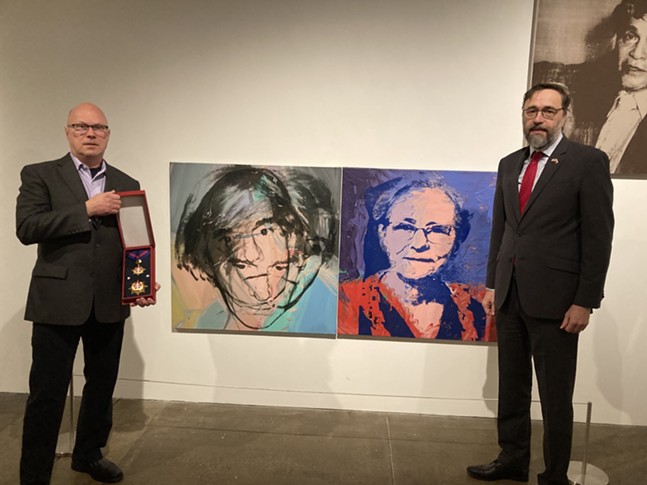
A bittersweet commemoration
Earlier this month, Čaputová gave a medal similar to Warhol’s to folk singer Joan Baez, who sang protest songs in the Slovak capital of Bratislava in 1989. Months later, communism collapsed. Baez returned to Slovakia in recent years to protest the murder of Kuciak.Warhol never visited his parents’ land, but Javorčík said he could not — Warhol reached his height as an artist during the depths of the Cold War.
The ambassador said Slovaks admire Warhol’s success as an underdog, the son of immigrants, who reached the pinnacle of society. And for that, they are proud.
“They may not agree with his view[s] and his art,” Javorčík said, “but they may appreciate that he was trying to make the world better.”
Located near his parents’ village, an Andy Warhol Museum opened in Slovakia before the one here. Warhol, who painted pictures of dollar bills, achieved another distinction — his 1964 silk screen of Marilyn Monroe’s face, “Sage Shot Blue Marilyn,” sold at Sotheby’s two years ago as the most expensive painting of the 20th century. It fetched $195 million.
If still alive, the frugal former Pittsburgher with a Slovak sense of humor might have laughed all the way to the bank. Yet the changes in his ancestral homeland — a homophobic prime minister and the murder of a reporter — might have also driven Warhol to belt down a glass of slivovica.

